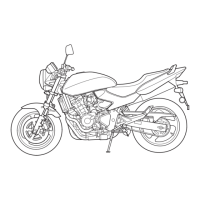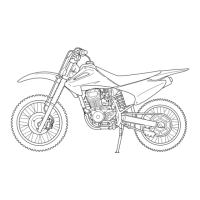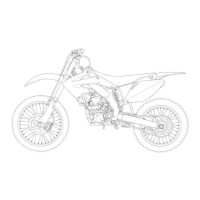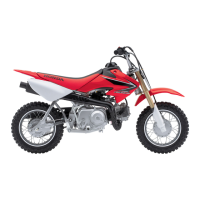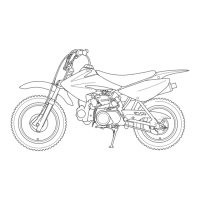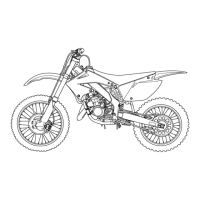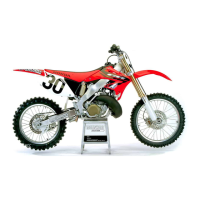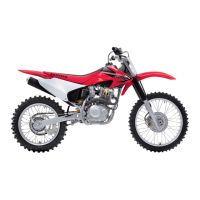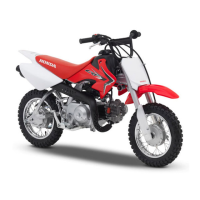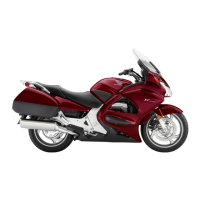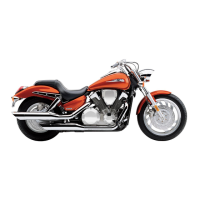Do you have a question about the Honda 2004 CBR600RR and is the answer not in the manual?
Motorcycle designed for operator and one passenger. Adhere to weight limits.
Motorcycle is designed for use only on the road.
Pay special attention to safety messages throughout the manual.
Explains safety messages and signal words like DANGER, WARNING, and CAUTION.
Details the meaning of DANGER, WARNING, and CAUTION signal words.
Tips for improving visibility to other road users for enhanced safety.
Advises on operating the motorcycle within personal abilities and road conditions.
Highlights the severe risks associated with consuming alcohol before riding.
Emphasizes the importance of regular maintenance and using approved accessories.
Suggestions for appropriate protective gear for riding.
Importance of helmets and eye protection for rider safety.
Recommendations for other riding gear like gloves and suits.
Specifies the maximum weight capacity for the motorcycle.
Provides advice on how to safely load the motorcycle.
Guidelines for carrying passengers or cargo safely.
Advice on using genuine Honda accessories and following guidelines.
Warning about potential dangers of improper modifications.
Advises against removing or modifying original equipment.
Identifies various controls and indicators on the handlebars and dashboard.
Illustrates the location of major components like the battery and tool box.
Locates suspension adjustment points and other chassis parts.
Describes the functions of various indicators and gauges.
Details the fuel gauge and coolant temperature meter functions.
Explains the features and operation of the multi-function display.
Describes the speedometer, odometer, and tripmeter functions.
Instructions for setting the digital clock time.
How to adjust front suspension spring preload and damping.
Instructions for adjusting rear suspension rebound and compression damping.
Details on adjusting rear shock absorber spring preload.
Describes the hydraulic disc brake system.
How to check the front brake fluid level.
Adjusting the front brake lever free play.
How to check the rear brake fluid level.
Steps for adjusting clutch lever free play.
Importance of lubricating the clutch cable.
Details on recommended coolant mixture and properties.
Procedure for checking the coolant level in the reserve tank.
Information on the fuel tank capacity and reserve supply.
Safety warnings related to fueling the motorcycle.
Specific petrol recommendations for different regions (E, G, BR, MX).
Advises on using fuels with or without alcohol content and potential issues.
Procedure for checking the engine oil level.
Guidance on changing engine oil and filter, and disposal.
Importance of correct tyre pressure for handling and safety.
How to inspect tyres for wear, damage, and foreign objects.
Minimum tread depth requirements for tyres.
Guidance on temporary and permanent tyre repairs.
Information on recommended tyre sizes and proper installation.
Describes the key positions and their functions.
Information about the motorcycle's keys and key number plate.
Explains the function and operation of the HISS security system.
Location and function of the engine stop and starter buttons.
Operation of headlight dimmer and turn signal switches.
Function of the passing light control switch.
How to engage and disengage the steering lock.
Instructions for removing and installing the front and rear seats.
Location and use of the helmet holder.
Location and purpose of the document bag.
Describes the storage compartment for an anti-theft lock.
Steps for removing and installing the lower cowl.
Procedures for removing and installing the front cowl.
How to adjust the vertical aim of the headlights.
Essential checks before riding the motorcycle.
Detailed procedure for starting the motorcycle engine.
Guidance on the initial running-in period for the motorcycle.
Basic instructions and tips for riding the motorcycle.
Techniques and safety tips for braking.
Proper procedures for parking the motorcycle.
Recommendations for preventing motorcycle theft.
Explains why regular maintenance is crucial for the motorcycle.
Safety precautions to follow during maintenance tasks.
General safety measures to be taken before and during maintenance.
Outline of recommended maintenance intervals and tasks.
Lists the items included in the motorcycle's tool kit.
Location of the frame and engine serial numbers for reference.
Identifies the location of the colour label for parts ordering.
Explains engine oil viscosity grades based on atmospheric temperature.
Lists recommended spark plug types for the motorcycle.
Instructions on checking and replacing spark plugs.
Steps for inspecting the drive chain for wear and damage.
How to check sprockets for wear and damage.
Procedure for adjusting the drive chain slack.
Guidance on lubricating and cleaning the drive chain.
How to inspect front and rear suspension components.
Checks for proper operation of the side stand and its spring.
Steps for removing the front wheel.
Procedures for installing the front wheel.
How to measure brake disc clearance.
How to inspect front brake pads for wear.
How to inspect rear brake pads for wear.
Information on battery type and basic maintenance.
Steps for safely removing the motorcycle battery.
Identifies the fuse box and lists fuse types and ratings.
Procedures for replacing main and FI fuses.
How to adjust the stoplight switch for proper operation.
Steps for replacing the headlight bulb.
Instructions for replacing the position light bulb.
Guidance on checking the stop and taillight functionality.
Procedures for replacing front and rear turn signal bulbs.
Steps for replacing the license light bulb.
Recommendations for cleaning the motorcycle's surfaces.
Detailed steps for washing the motorcycle.
Advice on polishing, waxing, and touch-up paint.
How to remove road salt and its effects.
Tips for maintaining painted aluminum wheels.
Steps for preparing the motorcycle for extended storage.
Specific actions for preventing rust and protecting parts during storage.
Procedures for taking the motorcycle out of storage.
Technical specifications for dimensions and dry weight.
Lists various fluid capacities and passenger capacity.
Details engine bore, stroke, displacement, and spark plug type.
Specifications for idle speed and cold valve clearance.
Specifications for caster angle and trail measurement.
Recommended tyre sizes for front and rear.
Lists primary and gear ratios for each speed.
Electrical system specifications for battery and generator.
Wattage and type for various lights.
Specifies ratings for main, FI, and other fuses.
Explains the role of catalytic converters and their care.
Information on regulations regarding the noise control system.
Motorcycle designed for operator and one passenger. Adhere to weight limits.
Motorcycle is designed for use only on the road.
Pay special attention to safety messages throughout the manual.
Explains safety messages and signal words like DANGER, WARNING, and CAUTION.
Details the meaning of DANGER, WARNING, and CAUTION signal words.
Tips for improving visibility to other road users for enhanced safety.
Advises on operating the motorcycle within personal abilities and road conditions.
Highlights the severe risks associated with consuming alcohol before riding.
Emphasizes the importance of regular maintenance and using approved accessories.
Suggestions for appropriate protective gear for riding.
Importance of helmets and eye protection for rider safety.
Recommendations for other riding gear like gloves and suits.
Specifies the maximum weight capacity for the motorcycle.
Provides advice on how to safely load the motorcycle.
Guidelines for carrying passengers or cargo safely.
Advice on using genuine Honda accessories and following guidelines.
Warning about potential dangers of improper modifications.
Advises against removing or modifying original equipment.
Identifies various controls and indicators on the handlebars and dashboard.
Illustrates the location of major components like the battery and tool box.
Locates suspension adjustment points and other chassis parts.
Describes the functions of various indicators and gauges.
Details the fuel gauge and coolant temperature meter functions.
Explains the features and operation of the multi-function display.
Describes the speedometer, odometer, and tripmeter functions.
Instructions for setting the digital clock time.
How to adjust front suspension spring preload and damping.
Instructions for adjusting rear suspension rebound and compression damping.
Details on adjusting rear shock absorber spring preload.
Describes the hydraulic disc brake system.
How to check the front brake fluid level.
Adjusting the front brake lever free play.
How to check the rear brake fluid level.
Steps for adjusting clutch lever free play.
Importance of lubricating the clutch cable.
Details on recommended coolant mixture and properties.
Procedure for checking the coolant level in the reserve tank.
Information on the fuel tank capacity and reserve supply.
Safety warnings related to fueling the motorcycle.
Specific petrol recommendations for different regions (E, G, BR, MX).
Advises on using fuels with or without alcohol content and potential issues.
Procedure for checking the engine oil level.
Guidance on changing engine oil and filter, and disposal.
Importance of correct tyre pressure for handling and safety.
How to inspect tyres for wear, damage, and foreign objects.
Minimum tread depth requirements for tyres.
Guidance on temporary and permanent tyre repairs.
Information on recommended tyre sizes and proper installation.
Describes the key positions and their functions.
Information about the motorcycle's keys and key number plate.
Explains the function and operation of the HISS security system.
Location and function of the engine stop and starter buttons.
Operation of headlight dimmer and turn signal switches.
Function of the passing light control switch.
How to engage and disengage the steering lock.
Instructions for removing and installing the front and rear seats.
Location and use of the helmet holder.
Location and purpose of the document bag.
Describes the storage compartment for an anti-theft lock.
Steps for removing and installing the lower cowl.
Procedures for removing and installing the front cowl.
How to adjust the vertical aim of the headlights.
Essential checks before riding the motorcycle.
Detailed procedure for starting the motorcycle engine.
Guidance on the initial running-in period for the motorcycle.
Basic instructions and tips for riding the motorcycle.
Techniques and safety tips for braking.
Proper procedures for parking the motorcycle.
Recommendations for preventing motorcycle theft.
Explains why regular maintenance is crucial for the motorcycle.
Safety precautions to follow during maintenance tasks.
General safety measures to be taken before and during maintenance.
Outline of recommended maintenance intervals and tasks.
Lists the items included in the motorcycle's tool kit.
Location of the frame and engine serial numbers for reference.
Identifies the location of the colour label for parts ordering.
Explains engine oil viscosity grades based on atmospheric temperature.
Lists recommended spark plug types for the motorcycle.
Instructions on checking and replacing spark plugs.
Steps for inspecting the drive chain for wear and damage.
How to check sprockets for wear and damage.
Procedure for adjusting the drive chain slack.
Guidance on lubricating and cleaning the drive chain.
How to inspect front and rear suspension components.
Checks for proper operation of the side stand and its spring.
Steps for removing the front wheel.
Procedures for installing the front wheel.
How to measure brake disc clearance.
How to inspect front brake pads for wear.
How to inspect rear brake pads for wear.
Information on battery type and basic maintenance.
Steps for safely removing the motorcycle battery.
Identifies the fuse box and lists fuse types and ratings.
Procedures for replacing main and FI fuses.
How to adjust the stoplight switch for proper operation.
Steps for replacing the headlight bulb.
Instructions for replacing the position light bulb.
Guidance on checking the stop and taillight functionality.
Procedures for replacing front and rear turn signal bulbs.
Steps for replacing the license light bulb.
Recommendations for cleaning the motorcycle's surfaces.
Detailed steps for washing the motorcycle.
Advice on polishing, waxing, and touch-up paint.
How to remove road salt and its effects.
Tips for maintaining painted aluminum wheels.
Steps for preparing the motorcycle for extended storage.
Specific actions for preventing rust and protecting parts during storage.
Procedures for taking the motorcycle out of storage.
Technical specifications for dimensions and dry weight.
Lists various fluid capacities and passenger capacity.
Details engine bore, stroke, displacement, and spark plug type.
Specifications for idle speed and cold valve clearance.
Specifications for caster angle and trail measurement.
Recommended tyre sizes for front and rear.
Lists primary and gear ratios for each speed.
Electrical system specifications for battery and generator.
Wattage and type for various lights.
Specifies ratings for main, FI, and other fuses.
Explains the role of catalytic converters and their care.
Information on regulations regarding the noise control system.
| Engine Type | 599cc liquid-cooled inline four-cylinder |
|---|---|
| Bore x Stroke | 67.0mm x 42.5mm |
| Compression Ratio | 12.0:1 |
| Ignition | Computer-controlled digital transistorized with 3-D mapping |
| Transmission | 6-speed |
| Final Drive | O-ring-sealed chain |
| Front Suspension | 41mm inverted HMAS cartridge fork with spring preload, rebound and compression damping adjustability; 4.7 inches travel |
| Rear Suspension | Unit Pro-Link HMAS single shock with spring preload, rebound and compression damping adjustability; 5.1 inches travel |
| Front Tire | 120/70ZR-17 |
| Rear Tire | 180/55ZR-17 |
| Wheelbase | 54.7 inches |
| Seat Height | 32.3 inches |
| Fuel Capacity | 4.8 gallons |
| Dry Weight | 370 pounds |
| Fuel System | PGM-DSFI with Denso dual-stage fuel injectors |
| Front Brakes | Dual 310 mm discs with four-piston calipers |
| Rear Brakes | Single 220mm disc |
